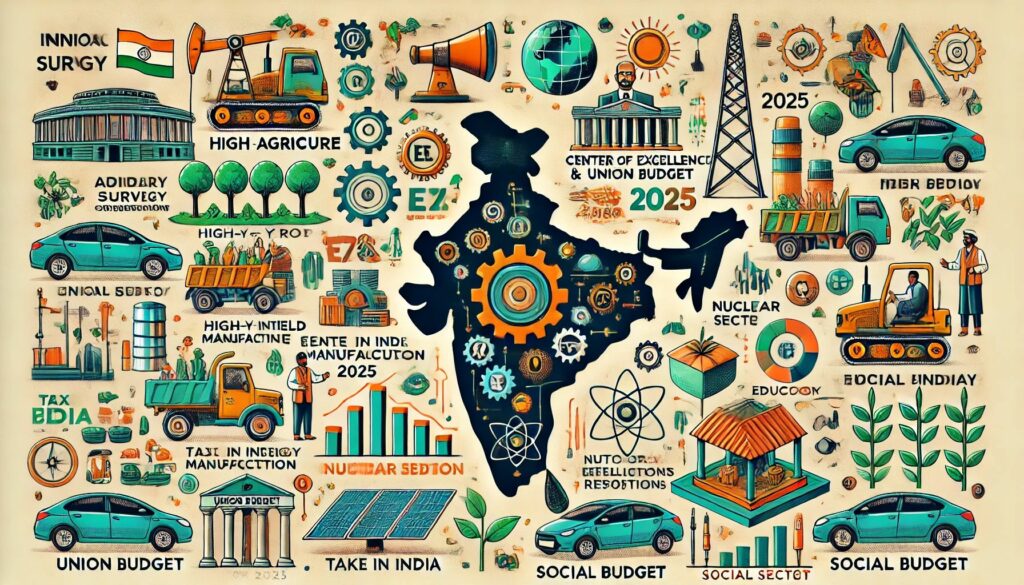
- The 2025 budget has heavily emphasized boosting the country’s two major drivers: consumption and savings.
- The economic survey shows that the Indian economy is stable, with a projected real GDP growth of 6.4% for FY 2024-25, close to the decadal average.
- Foreign exchange reserves for the country are high and as of September 2024 are reported to reach an impressive amount of $706 billion.
- The government has, as in the recent past, focused on infrastructure development with considerable investments in physical and digital infrastructure.
The Economic Survey 2025, presented by Finance Minister Nirmala Sitharaman, is very insightful in appreciating the Indian economy, tracking its performance, and its projections for the upcoming financial year. The statistics revealed India’s robust economic stability despite increasing global uncertainties.
India’s Economic Stability
The survey shows that the Indian economy is stable, with a projected real GDP growth of 6.4% for FY 2024-25, close to the decadal average. It is a reassuring sign given global challenges. At the same time, the economic output of the country in terms of real gross value added (GVA) is also likely to grow at the same rate with the strength of domestic consumption and investment.
Controlling Inflation
Inflation, which had been a thorn in the side of the last couple of years, has eased down. It came down from 5.4% in FY 2023-24 to 4.9% in the first half of FY 2024-25, a good sign that policies by the government are yielding. The RBI experts and those of the IMF think that inflation is going to reach the target RBI has set close to 4% by FY 2026.
Foreign Investment Trends
The outflows of FPIs did experience some global uncertainty, though the strong fundamentals of the Indian economy ensured that outflows were not too sizeable. In the case of FDI too, there was a sign of revival, although net inflows were a little lower than that of the previous year due to an increase in repatriation by foreign investors.
Forex Reserves
Foreign exchange reserves for the country are high and as of September 2024 are reported to reach an impressive amount of $706 billion, hence it covers around 90% of the foreign debt of the country. It may have gone down to around $640.3 billion in December 2024, however, the reserves stand to be able to protect against any shocks from the world.
Health of Banking and Insurance Sector
The Indian banking sector is also in good health. NPA ratios, an indicator of the health of the banking system, have reduced to a mere 2.6% by September 2024. Credit growth to MSMEs has been more than to large industries. The insurance sector, too, is growing, and pension subscriptions rose by 16% year over year by September 2024.
Trade Balance and Exports
India’s exports, both goods and services, increased by 6% in the first nine months of FY 2025 to USD 602.6 billion. Exports excluding petroleum and gems grew even faster at 10.4%. Imports rose by 6.9% on the back of strong domestic demand. This calls for India to focus on diversifying its trade and adapting to the evolving global trade landscape, which is increasingly turning towards protectionism.
Credit Growth and MSME Support
The India credit growth continues to stay robust and largely for MSMEs at 13 per cent year-on-year, which dwarfs the growth of 6.1 per cent for larger businesses. The growth of agricultural credit came in at 5.1 per cent with personal loan growth moderating at 8.8 per cent primarily due to a vehicle and housing loan decline.
A Call for Deregulation
The Economic Survey recommends speeding up deregulation as a way of promoting economic growth. It supports deregulatory bottlenecks, promotes economic freedoms, and invests in skills development as ways to support businesses. This way, India will have the chance to further increase its capacity for producing quality commodities and services that sustain long-term growth. Infrastructure Development and Private Sector Involvement
The government has, in the recent past, focused on infrastructure development with huge investments in physical and digital infrastructure. However, the survey insists that public funds will not be sufficient to cater for the growing demands for infrastructure. In this regard, the government has been challenged to improve private sector participation through public-private partnerships (PPPs), improving mechanisms for risk-sharing, project management, and contract enforcement.
Major Announcements in Union Budget 2025-26
The Union Budget brings forward several proposals aimed at taxation, agriculture, technology and all-round infrastructure development to fasten economic growth.
Tax Reforms
- Income Tax Exemption Increased: The government has increased the tax exemption limit to ₹12 lakh per year, providing relief to the middle class and encouraging spending.
- Increased TDS Limits:
- For senior citizens, the TDS limit on interest earnings has been doubled from ₹50,000 to ₹100,000.
- For rent payments, the TDS limit has been raised from ₹2.4 lakh to ₹6 lakh per year.
Agriculture and Rural Development
- Dhan-Dhaanya Krishi Yojana: A new program for 100 poorest-agricultural-productivity districts, which will provide financial and technical assistance to more than 17 million farmers.
- Expansion of Kisan Credit Card: The program will now allow short-term credit of up to ₹5 lakh to farmers, dairy owners, and fishermen. It will provide an impetus to the rural economy.
Science, Technology and Innovation
- Investment of ₹20,000 crore in R&D and innovation in a manner that is privately sector-driven.10,000 new research fellowships at IITs and IISc in emerging areas
Manufacturing and Exports
- Electronics & EV Industry Boost: Tax exemptions for LED/LCD TV components and lithium-ion battery manufacturing to promote domestic production.
Shipbuilding and MRO Sector
- A 10-year tax break for shipbuilding and shipbreaking materials.
- Extended export deadlines for railway maintenance equipment.
Infrastructure and Energy
- Nuclear Power Expansion: India aims to achieve 100 GW of nuclear energy by 2047 to meet its long-term energy needs.
Defence
The defence budget for 2025 has been set at Rs 6.81 trillion. This is just a marginal increase from last year’s Rs 6.22 trillion, though it still is only about 1.9% of India’s GDP as against 2.4% in FY21. The capital expenditure will account for Rs 1.8 trillion, involving aircraft, engines, the naval fleet, and other critical equipment. Defence pensions are a massive portion, and Rs 1.61 trillion is provided for that. A very strong case is made out for better border infrastructure with provisions exceeding Rs 7,000 crore for Border Roads Organisation.
The Defence Research and Development Organisation gets Rs 26,800 crore. India’s ministry feels that despite an increase in the budget, it should be spending at least 3% of its GDP on defence, especially when it faces threats from nuclear-armed rivals. In its efforts to streamline operations, the Ministry of Defence has identified 2025 as a year for major reforms in acquisition procedures. Despite all this, defence spending has not kept pace with India’s economic rise, causing concerns about the balance between national security priorities and broader social development needs.
Benefits to Economy
The 2025 budget has been more or less positive towards consumption and savings. It has heavily emphasized boosting the country’s two major drivers: consumption and savings. The government has focused a lot on stimulating consumption to increase demand, which might in turn increase overall output in the economy. This move is due to recent stagnation in consumption within India, which has been partly attributed to the heavy tax burden on citizens.
Overall, the government aims to reduce this burden to encourage consumption and therefore increase the GDP. The second aspect is enhancing the savings for its citizens to drive the broader government goals of monetary inclusion and enhance the money multiplier effect. Higher savings lead to the inflow of money into financial institutions, which in turn can result in increased lending and the creation of financial prudence in the country.
References:
- https://www.investindia.gov.in/team-india-blogs/indias-union-budget-fy-2025-26-key-takeaways
- https://www.moneycontrol.com/budget/budget-2025-is-a-forward-thinking-blueprint-for-india-s-economic-growth-article-12927570.html
- https://www.ndtv.com/business-news/how-much-will-india-spend-on-defence-this-year-a-summary-7611771
- https://www.thehindu.com/business/budget/economic-survey-2025-live-updates-budget-session-2025-26/article69162281.ece
Aayush Pal is a freelance writer on contemporary geopolitical developments. The views expressed in his work are entirely his own.
